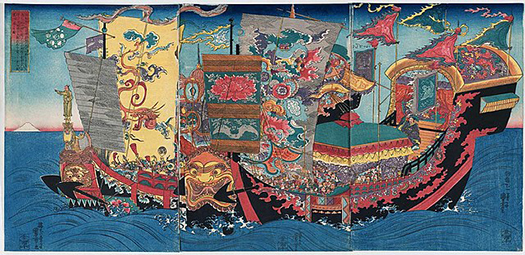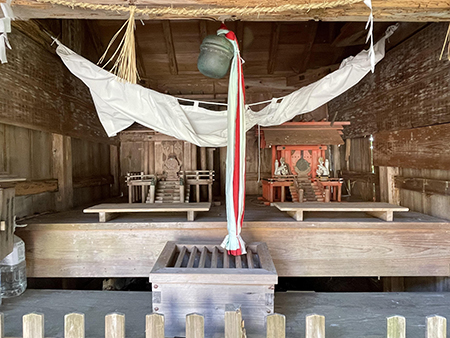


さてきのうの続編。徐福伝説という物語自体はあらすじは理解できたのですが、わたし的には、有名な「史記」に記述があるとは言え、なぜそのような中国王朝での説話が日本に根付いたのか?という疑問。歴史書に記載があるとは言え、中国社会ですら永く俗説とされてきたことに、なぜ日本社会は一定の存続根拠を維持し続けたのか、ということですね。
普通に科学的に考えれば、紀元前219年の段階の「航海術」では片道1000kmくらいはある意図的遠洋航海が可能だったとは思われない。はるかに時代を下る唐の時代、日本に仏教を伝えるために「国禁」であった渡航を試みた鑑真の数次にわたる難波例を見てもあきらか。安定的・合理的航海術が存在していたはずがない。仮に渡航事例があったとしてもそれは安定的なものではなく、命からがらの末の偶然であろうし、目的的な結果として渡海が可能だったとは思われない。
ただ、日本は歴史的に東アジアの「フロンティア」的な存在としてたくさんの大陸・半島地域のひとびとにとっての対象地域であっただろうことは事実。現実に日本社会の文化発展はそうした「渡来」によって多くがもたらされること自体は連綿と続いていた。
Wikiで検索すると「徐福伝説」を地域のひとつの継承文化としているのは、この稿で探訪した熊野地域のほかに福岡県八女市、佐賀県佐賀市、京都府伊根町、長野県佐久市、鹿児島県出水市・いちき串木野市、宮崎県延岡市、広島県廿日市市、愛知県一宮市・豊川市、東京都八丈町、秋田県男鹿市、青森県中泊町などに伝承が存在する。多くは「海民」文化が基底にある地域、もしくは関連地域。
上の絵図は歌川国芳画ということで江戸期の浮世絵の題材としてまで登場している。そういう古代浪漫に対して日本人は積極的に受け入れる素地があったということなのでしょう。八百万というきわめて新規受容性の高い地神崇拝が民族的な素地を形成していたというようにも考えられる。
アジア世界の文化中心であった中国王朝の史書にせっかく書き込まれている日本に関連するようなことがらを、ムダにはしないという心理素地なのではと考えられるのですね。活かして使えと。
実際の徐福がどうしたこうしたということよりも、こういった日本人社会の側面、真実性の方がわたし的にはたいへん興味深く考えさせられる。
やはり「旺盛な受容性」の表現であると思えるのですね。
多くの移民者を受け入れ続けてきた社会がその根底に培ってきた柔軟性というようにも言える。四周を海に囲まれた列島社会の基本的な性格として、これをわたしたちは共有しているのではないか。熊野地域では一種の地域特性として歴世、この民族性が色濃く遺り続けたということではないでしょうか?
English version⬇
Nippon “Utilizing” the Xufuku Legend: A Journey to Kumano and the Myth of the Imperial Family – 11
The Japanese people have a mindset of “eight million people” who believe that if such a legend exists, they should make full use of it. Japanese society has cultivated a vigorous receptivity. …
Now, the sequel to yesterday’s article. I understood the outline of the Xu Fu legend, but my question is why such a legend from the Chinese dynasties took root in Japan, even though it is written in the famous “Shiji” (Records of Ancient Matters). I am wondering why such a legend from the Chinese dynasties took root in Japan, even though it is mentioned in the famous “Shiji”. Why did Japanese society continue to maintain a certain basis for its existence when even Chinese society had long regarded it as a myth, even though it was mentioned in the history books?
From a normal scientific point of view, it is unlikely that the “art of navigation” as of 219 B.C. would have been capable of intentional oceanic voyages that were about 1,000 km each way. It is clear from the many cases of Kanjin’s attempts to travel to Japan to introduce Buddhism, which was forbidden by the Japanese government, during the Tang Dynasty, which was a long time later. There is no way that stable and rational navigation techniques could have existed. Even if there had been such a case, it would not have been stable, but would have been a coincidence of a desperate attempt to cross the sea, and it is unlikely that it would have been possible to cross the sea as a purposeful result.
However, it is true that Japan has historically been a “frontier” region in East Asia and a target of many continental and peninsular peoples. In fact, the cultural development of Japanese society has been largely due to the “arrival” of people from other parts of the world.
A Wiki search reveals that, in addition to the Kumano region explored in this article, the legend of Xu Fu is also part of the local cultural heritage in Yame City, Fukuoka Prefecture; Saga City, Saga Prefecture; Ine Town, Kyoto Prefecture; Saku City, Nagano Prefecture; Izumi City and Ichiki-Kushikino City, Kagoshima Prefecture; Nobeoka City, Miyazaki Prefecture; Hatsukaichi City, Hiroshima Prefecture; Ichinomiya City and Toyokawa City, Aichi Prefecture; Hachijo Town, Tokyo Prefecture, Oga City, Akita Prefecture, and Nakadomari Town, Aomori Prefecture. Many are areas where the “sea people” culture is based or related to the “sea people” culture.
The above illustration, painted by Utagawa Kuniyoshi, has even appeared as a subject in ukiyoe paintings of the Edo period. The Japanese people were willing to accept this kind of ancient romance. It is also conceivable that the worship of the earth gods, “Ya-million,” which was highly receptive to new ideas, formed the foundation of the Japanese people’s ethnic identity.
It is thought that this is a psychological background that does not want to waste things related to Japan that are written in the history books of the Chinese dynasties, which were the cultural center of the Asian world. Make the best use of it.
This aspect of Japanese society and its truthfulness is more interesting and thought-provoking to me than what Xu Fu actually did.
It seems to me that this is an expression of “vigorous receptivity.
It could be said that it is the flexibility that has been cultivated at the root of a society that has continued to accept many immigrants. We may share this as a basic characteristic of an archipelagic society surrounded by the sea on all sides. In the Kumano region, this ethnicity has remained strong throughout the ages as a kind of regional characteristic.
Posted on 1月 12th, 2024 by 三木 奎吾
Filed under: 日本社会・文化研究







コメントを投稿
「※誹謗中傷や、悪意のある書き込み、営利目的などのコメントを防ぐために、投稿された全てのコメントは一時的に保留されますのでご了承ください。」
You must be logged in to post a comment.